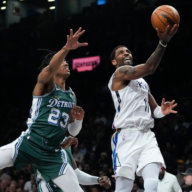
The Nets rode an excellent fourth quarter to victory, outscoring Indiana 28-11, and their offensive success came from bucking conventional wisdom. What makes the Pacers so successful defensively is their ability to turn away shots near the rim. The Pacers are full of long defenders like 7’2″ Roy Hibbert and Ian Mahinmi in their frontcourt, and buoy those talents with quick, long wing defenders like the 6’9″ Paul George turning away shots. The Pacers focus their defense close to the rim and at the corners, as you can see from their shot chart:
Allowing 47.8% from within five feet is almost 9% below the league average, a staggering number. To put it in perspective, the difference between their defense and a league-average defense is 5.5 points per game — at the rim alone.
For three quarters, the Nets fell into this trap. They attacked directly at Hibbert, Mahinmi, and George, and though they got Hibbert and George into foul trouble, it led to numerous offensive issues; after three quarters the Nets were just 11-33 from within five feet, a testament again to Indiana’s stellar defense from an area teams normally shoot far better in.
But in the fourth, the Nets turned Indiana’s defense against itself, and tore it apart with the illusion of rim-attacking. Throughout that final frame, a Brooklyn guard (usually Deron Williams) would probe the lane under the guise of attempting another ill-advised shot in the paint. Only this time, once Williams had drawn the attention of the defense, he immediately kicked it out to one of his open shooters, usually Joe Johnson or Brook Lopez.
After a rough offensive start to the game, Lopez finished the fourth quarter 4-6 from the field, three of his field goals open jumpers in key moments. “It helps us a lot,” Williams said after the game of Lopez’s shooting, “It spreads the floor, spaces the floor, and it lets guys be able to work in the middle when he is out there knocking down jumpers like that.”
“I do think it opens up a lot,” Lopez added. “I’ve been working on that. When I’m open, I’ve got to be confident and shoot it.”
After attempting an average of 11 shots at the rim in each of the first three quarters, the Nets attempted just five in the fourth — but hit six open jumpers from 15 feet and beyond to retake the lead for good.
Check out the video from the fourth quarter and you’ll see a pattern: Deron Williams or Joe Johnson probe the lane, the defense immediately draws in, and once there’s a sliver of space, the ball kicks out to an open Lopez or Johnson for the jumper.
(That Lopez dunk is also thrown in, because why not?)
This type of offensive seems counter-productive; ideally you’d like your shooting attempts going towards the rim (where both field goal percentage and the chance of drawing fouls increases), and teams that rely primarily on the midrange shot don’t often find success. But Indiana’s defense is unique in the league, and the Nets adjusted their offense to most effectively attack it when they needed to most.


















